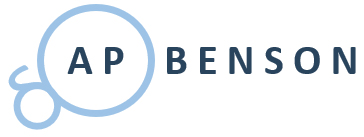Quality assurance of business models is critical if the outputs are to be relied upon by clients and to have some credibility in business decision making.
Quality assurance of the finished model will need to be established at some key levels. AP Benson utilises standard internal approaches and checklists to establish the efficacy of this type of financial model.
Model quality assurance provides an independent "audit" of the model and demonstrates the work that has been completed to check model efficacy.
We assume below that the model will comprise profit, cash flow and balance sheet forecasts supported by work sheets that make various calculations such as employee costs, rental costs, sales forecasts etc. These work sheets link directly to the main forecasts or indirectly via further analysis working sheets.
1. Modelling Accuracy
This exercise is usually completed on a paper copy of the model which is annotated to evidence that the requisite checks have been carried out. The various formulae used and arithmetical operations carried out on data will be checked:
- Supporting working and analysis sheets will be checked for arithmetical accuracy
- The linkages between supporting and analysis sheets to subsequent sheets and to the main model will be checked
- The application of the formulae will be checked to ensure that they have been applied correctly
- The accounting accuracy of data included in the model will be checked e.g. the additions in profit and loss forecasts, the debtor day and creditor day calculations, the construction of balance sheets from the forecast figures, the transfer of accruals based profit accounting to cash based cash flow accounting, the calculation of opening and closing cash balances, interest rates applied and the basis upon which interest is calculated, application of taxation principles in, for example, VAT payment dates, PAYE/NI payments and corporation tax payments.
2. Logic Check
A logic check on a model of this type begins with a diagrammatical representation of the model's construction as this is an easy way to communicate the logic behind the model to the personnel within the organisation who are responsible for the model's construction. In this way the quality assurer will "walk through" the logic of the model in order to ensure that all key factors have been considered.
Sales in the profit and loss forecast may arise from a sales forecast that is derived from a demand & a capacity forecast. The capacity forecast arises from an understanding of employee numbers and historic experience of holidays and sick days.
3. Completeness
Completeness of the model is also ensured by this type of logic representation but also utilises existing expenditure data for individual departments to ensure that all cost categories have been included.
Further issues around completeness include checks against standard AP Benson modelling templates to ensure all significant and relevant categories are included, review of authority plans in order to ensure that scenarios are properly reflected and accounting checks on data. Accounting checks on data are designed to ensure that the model is internally complete and usually highlights any discrepancies.
Such checks would include comparison of net asset totals on subsequent years' balance sheets to prove forecast profit figures, cash summaries (that utilise movements in debtors & creditors) to prove cash flow forecasts, development of control accounts to prove opening and closing debtor, creditor, VAT, PAYE figures etc.
4. Basis of Assumptions
It is a key requirement for this type of work that assumptions are recorded within a master list as they are made. Part of the quality assurance work is to ensure that all assumptions have been recorded.
These are then formulated into a check list and tested within the model to ensure that they have been accurately recorded therein.
Further these assumptions are reviewed in order to ensure that they are internally consistent, logical and also supported by plans and other data, such as employee salary rates, existing credit terms paid by the authorities etc.
A key output of this type of work would be a summary of the key assumptions so that the model can be qualified as being subject to some important issues.
5. Robustness
We aim to test the robustness of the model in a variety of ways in order to ensure that it will withstand illogical inputs and also that it is capable of allowing a user to test a variety of scenarios that were not considered at the outset i.e. to ensure that the model has not been inadvertently "hard wired".
Testing includes:
- Ensuring that the model is capable of flexibility in the inputs that are permitted. This would ensure that the model has not been inadvertently "hard wired" and does have the flexibility to allow the user to change a large range of factors in order to assess their impact
- That the model is capable of producing logical results even when illogical data is input e.g. if the number of debtor days is reduced to zero does the inflow of cash match the sales in the relevant month and does the VAT liability remain the same having been calculated on an accruals basis?
In conclusion our approach is comprehensive and focussed on accuracy.
More recent information on AP Benson financial modelling and review work can be found [here] and [here].


 ERP and Professional Services Automation
ERP and Professional Services Automation 
